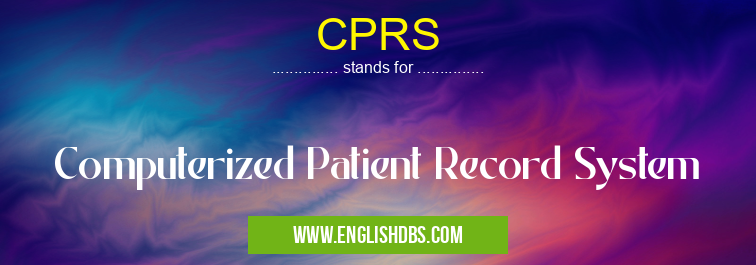What does CPRS mean in HOSPITALS
The Computerized Patient Record System (CPRS) is a powerful electronic medical record (EMR) system developed by the US Department of Veterans Affairs for use in their hospitals and clinics. It is used by healthcare professionals to capture, store, review, and manage patient information. CPRS is an integrated system that comprises of a comprehensive database from which clinicians can retrieve information pertaining to their patients' medical histories. With this data at their disposal, physicians are able to deliver quality care while eliminating unnecessary paperwork and manual processes. CPRS helps improve workflow and enables clinicians to spend more time with patients instead of worrying about paperwork.

CPRS meaning in Hospitals in Medical
CPRS mostly used in an acronym Hospitals in Category Medical that means Computerized Patient Record System
Shorthand: CPRS,
Full Form: Computerized Patient Record System
For more information of "Computerized Patient Record System", see the section below.
Benefits
CPRS provides health care providers with real-time access to critical patient data while ensuring patient privacy and security. The system includes comprehensive patient records, including demographics, diagnoses, medications, laboratory results, procedures, allergies, immunizations and more. CPRS also provides alerts to medical staff when changes occur in the clinical picture or when certain protocols should be followed or avoided. This helps ensure that all aspects of the patient's care are considered when making decisions regarding treatment plans or prescribing medications/treatments. In addition to providing timely access to relevant data, CPRS allows for better communication between health care professionals so that they can collaborate on cases in order for the best possible outcome for each patient.
Essential Questions and Answers on Computerized Patient Record System in "MEDICAL»HOSP"
What is CPRS?
CPRS stands for Computerized Patient Record System. It is a secure, web-based electronic medical record system that consolidates patient data from multiple sources into a single, integrated database. The system is designed to provide healthcare professionals with quick and easy access to comprehensive patient information.
How does CPRS help clinicians care for patients?
CPRS allows clinicians to store, view, and manage patient records in one secure location, helping them to provide better care for their patients. All of the patient's vital medical information such as medical history, lab results, medications, allergies and more are stored in one place which can be accessed easily from anywhere. This makes it easier for clinicians to make informed decisions quickly and accurately.
What types of information are included in CPRS?
In addition to demographic information, CPRS contains clinical notes, lab reports, diagnostic imaging results, progress notes and medication orders for each individual patient. Additionally, the system allows users to track appointments and referrals as well as generate health summaries which can be shared with other providers.
How secure is the data stored in CPRS?
CPRS is designed with security in mind. The system stores all patient information using encryption techniques which ensure the data remains protected even if the computer or network it is stored on is compromised. The system also implements user authentication measures which require users to enter their credentials before they can access any records within the system.
Who has access to patient records stored in CPRS?
Access to a patient's record within the system is strictly controlled by user authentication protocols; only those users who have been granted specific permission have access to any particular record within the system. Furthermore, during data transmission between computers additional measures are taken such as digital certificates and encryption algorithms further ensuring that all patient data remains secure at all times.
How often should I update my records in CPRS?
It’s important that your records remain up-to-date in order for your healthcare team to provide you with better care; it’s recommended that you update your records periodically or whenever there is a change in your condition or treatment plan so that everyone has access to accurate information about your health status.
What happens when I need medical attention away from my usual healthcare facility?
If you receive medical attention away from your regular facility then any relevant changes made by other providers will still be securely kept on file within CPRS—this ensures continuity of care whenever needed without having to transfer physical documents between multiple locations.
Are there training materials available on how best use this system?
Yes! You have full access to an online library of resources including interactive tutorials and user guides which cover everything from basic navigation of the software right up advanced level technical details—ensuring that you are able to get up-to-date quickly and start using this powerful tool quickly so that you can provide superior care for your patients.
Final Words:
In summary, the Computerized Patient Record System (CPRS) is a vital tool for providing quality healthcare services in an efficient manner while ensuring patient confidentiality and security. By providing clinicians with real-time access to comprehensive medical records in an integrated format; physicians can make informed decisions regarding their patients’ wellbeing without having to worry about manual paperwork or outdated practices getting in the way of quality care delivery. As technology continues to develop and evolve, it is expected that existing systems like CPRS will also continue to advance and become even more effective tools within healthcare settings.
